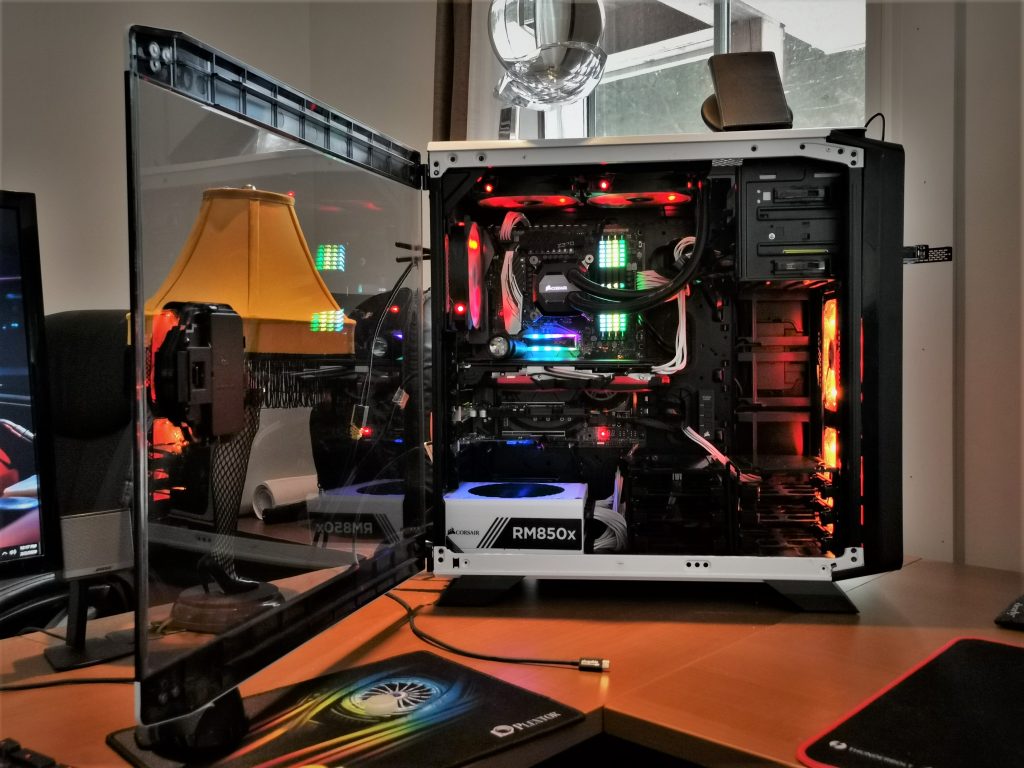TSSDR TEST BENCH AND PROTOCOL
SSD testing at TSSDR differs slightly, depending on whether we are looking at consumer or enterprise storage media. For our Sabrent Rocket Q 4TB NVMe PCIe 3 SSD testing today, our goal is to test in a system that has been optimized with our SSD Optimization Guide. To see the best performance possible, the CPU C states have been disabled, C1E support has been disabled, and Enhanced Intel SpeedStep Technology (EIST) has been disabled.
SYSTEM COMPONENTS
The components of this Test Bench are detailed below. All hardware is linked for purchase and product sales may be reached by a simple click on the individual item. As well, the title is linked back to the individual build article where performance testing can be validated.
TSSDR ASROCK Z370 TAICHI TEST BENCH (link)
| PC CHASSIS: | Corsair Graphite 760T Arctic White Window Chassis |
| MOTHERBOARD: | ASRock Z370 Taichi |
| CPU: | Intel Coffee Lake Core i7-8770K |
| CPU COOLER: | Corsair Hydro Series H110i GTX |
| POWER SUPPLY: | Corsair RM850x 80Plus |
| GRAPHICS: | MSI Radeon RX570 |
| MEMORY: | Corsair Vengeance RGB 32GB DDR4 3600Mhz C18 |
| STORAGE: | Intel Optane 900P 480GB SSD |
| KEYBOARD: | Corsair Strafe RGB Silent Gaming |
| MOUSE: | Corsair M65 Pro Gaming |
| OS | Microsoft Windows 10 Pro 64 Bit |
BENCHMARK SOFTWARE
The software in use for today’s analysis is typical of many of our reviews and consists of Crystal Disk Info, ATTO Disk Benchmark, Crystal Disk Mark, AS SSD, Anvil’s Storage Utilities, AJA, and TxBench. Our selection of software allows each to build on the last and to provide validation to results already obtained.
Crystal Disk Info is a great tool for displaying the characteristics and health of storage devices. It displays everything from temperatures, the number of hours the device has been powered, and even to the extent of informing you of the firmware of the device.
Crystal Disk Info validates that our SSD is running in PCIe 3.0 x4 (four lane), and also that NVMe 1.3 protocol is in use.
ATTO Disk Benchmark is perhaps one of the oldest benchmarks going and is definitely the main staple for manufacturer performance specifications. ATTO uses RAW or compressible data and, for our benchmarks, we use a set length of 256mb and test both the read and write performance of various transfer sizes ranging from 0.5 to 8192kb. Manufacturers prefer this method of testing as it deals with raw (compressible) data rather than random (includes incompressible data) which, although more realistic, results in lower performance results.
Listed specifications for the Sabrent Rocket Q NVMe 4TB SSD are 3450MB/s read and 3000MB/s write. These results are pretty much bang on, but just as importantly, there is a very steady speed progression with data size increase.
 The SSD Review The Worlds Dedicated SSD Education and Review Resource |
The SSD Review The Worlds Dedicated SSD Education and Review Resource | 


You have the NAND listed as TLC in the 8th paragraph but, it’s actually QLC. Also, are you still hiring I sent you a couple of emails on January 30th of this year and December 30th of last year. And a tweet.
Thanks… mistake. Have not received e-mails. Send to thessdreview@gmail.com
As these (and all other Rocket Q units) are QLC, and therefore presumably use a TLC/MLC/SLC write cache: do we know at what the write throughput ends up being during periods when that cache is saturated?
B
james lawson
Ive got 4tb samsung QVO SATA drive that i got for £312 black friday deal…
But i think this is the only consumer 4TB NVMe. Pricey tho
This is the Sabrent Rocket Q with the branding removed. This is the ONLY company in the industry that we know of that actually uses copper branding to help with heat dissipation.
> Samsung 970 EVO Plus does have this. as far I remeber.
I have three 970 EVO Pluses behind me and none have branding such as that. Check our review below! Sabrent was the first but ADATA has followed suit with their Falcon and swordfish SSDs.
https://www.thessdreview.com/our-reviews/samsung-970-evo-plus-nvme-ssd-review-250gb-1tb-knockout-performance-at-a-value-price/